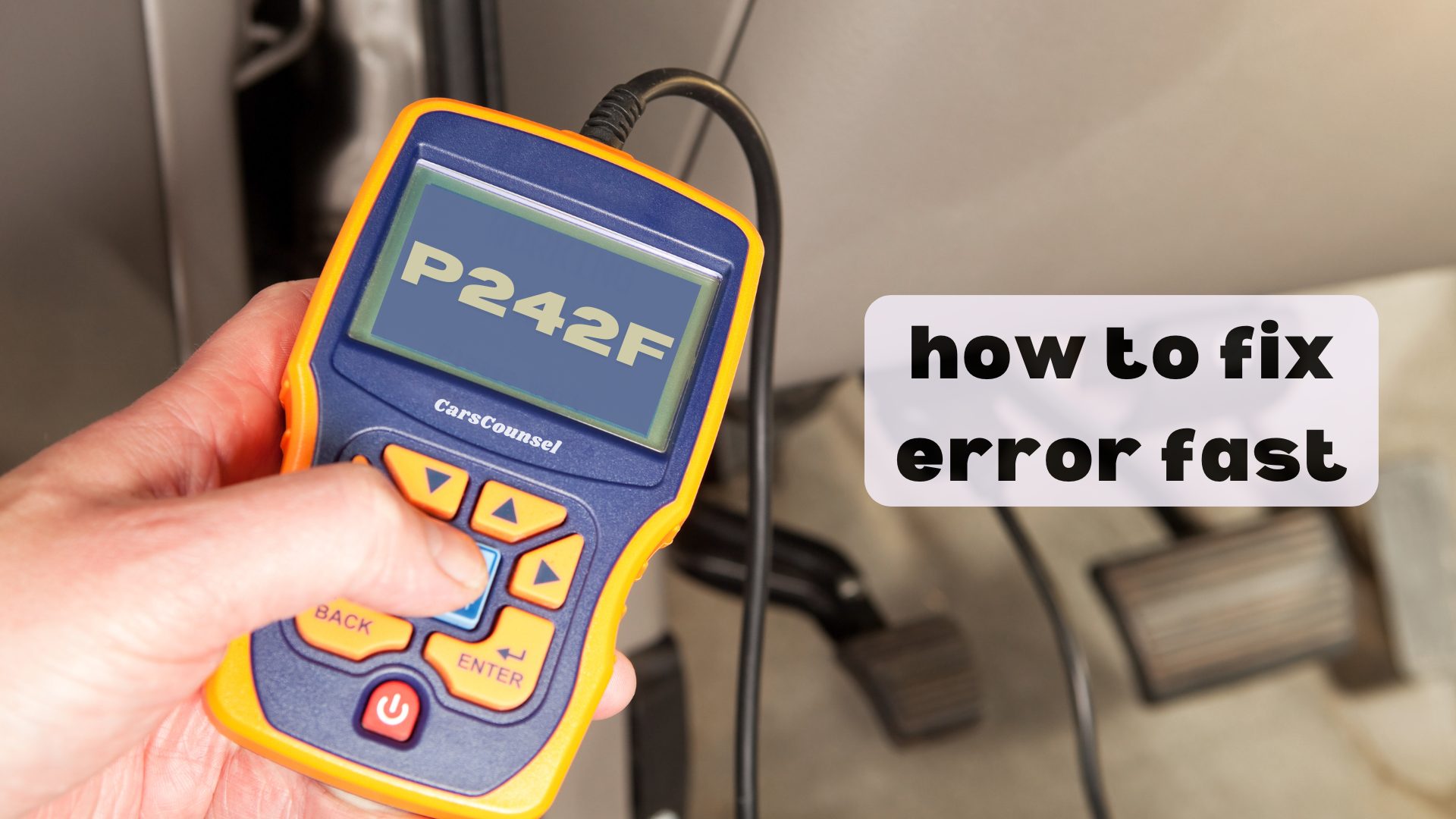Did you know that nearly 30% of diesel vehicles will run into a P242F code at some point?
This error is usually connected to the Diesel Particulate Filter (DPF) and can be a real hassle if not dealt with quickly.
To fix it fast, start with an OBD-II scanner to confirm the error code and check for other related codes.
But what if the problem sticks around even after you’ve looked over the DPF thoroughly?
There’s more going on than you might think, and getting to the bottom of it will save you time and headaches.

Quick Navigation
Key Takeaways
- Use an OBD-II scanner to check for the P242F code and any related codes.
- Look at the Diesel Particulate Filter (DPF) to see if there are any blockages or damage.
- Clean or replace any sensors that might be causing the problem.
- Use a good DPF cleaning solution and carefully follow the instructions.
Understanding P242F Code
Understanding the P242F Code
The P242F code indicates that there’s a problem with your Diesel Particulate Filter (DPF) due to ash buildup. The DPF is crucial for capturing soot and ash from exhaust gases, but over time, ash can clog the filter, reducing its effectiveness.
To deal with this issue, first use an OBD-II scanner to verify the P242F code. Then, visually inspect the DPF for any signs of blockage.
Check and either clean or replace any sensors that might be giving incorrect readings.
Regular maintenance and occasionally driving at higher speeds can help clean out the DPF, preventing excessive ash buildup and keeping your engine running smoothly.
Common Symptoms
If you see the P242F code, it usually comes with clear signs that something is wrong with your Diesel Particulate Filter (DPF). Spotting these signs early can help you fix the problem before it gets worse.
| Symptom | Description |
|---|---|
| Loss of Power | Your engine doesn’t perform well and has slower acceleration. |
| Increased Emissions | There’s a lot more smoke coming from your exhaust. |
| Reduced Fuel Economy | You’re getting fewer miles per gallon because your engine is inefficient. |
| Warning Lights | The check engine light is on. |
| Engine Stalling | Your engine suddenly stalls or idles roughly. |
Common causes include a clogged DPF, bad sensors, and fuel system problems. Fixing these issues quickly ensures your vehicle runs smoothly and efficiently.
Driving Habits Impact
Frequent stop-and-go traffic and short trips can stop the Diesel Particulate Filter (DPF) from cleaning itself properly, causing ash to build up and triggering the P242F code.
To avoid this, you should change your driving habits. Try to avoid short trips that don’t let the engine warm up fully. Instead, take longer drives to help the DPF clean itself.
Also, keep a steady speed on highways to help the DPF burn off the soot. Driving at high speeds is especially good for this.
Faulty Sensors
Adjusting how you drive can help, but it’s also crucial to fix any faulty sensors to clear the P242F code.
Start by connecting your car to an OBD-II scanner to find any sensor problems. Use the scanner to check for unusual pressure and temperature readings from the sensors.
If you notice anything off, look at the sensors for damage or soot buildup. Clean or replace any bad sensors right away.
Make sure all connectors and wires are secure and not corroded. Use the scanner to reset the fault code, then take your car for a test drive to make sure the problem is fixed.
Regularly checking the sensors can help avoid future P242F codes and keep your car running well.
Fuel System Issues
Fuel system issues, like leaks or clogged injectors, can cause poor combustion and lead to the P242F code. Fixing these problems is crucial for good fuel efficiency and ensuring diesel quality.
Here’s what to do:
- Check for Leaks: Look at all the lines and connections to make sure there are no fuel leaks.
- Clean Injectors: Use a cleaning solution to clear any clogs and ensure the fuel sprays properly.
- Replace Filters: Change fuel filters regularly to keep out contaminants.
- Use Good Diesel: Always use high-quality diesel to reduce soot production.
EGR System Problems
Fixing fuel system problems is important, but you also need to make sure the EGR system is working right to stop too much soot buildup and avoid getting a P242F code. Start by checking the EGR valve for any blockages and make sure it moves smoothly. Clean or replace any clogged parts to get it working again.
| Step | Action |
|---|---|
| 1 | Check the EGR valve for blockages |
| 2 | Clean the EGR valve and passages |
| 3 | Test if the EGR valve works |
| 4 | Replace any bad EGR parts |
If the EGR system isn’t working well, it can cause too much soot, making DPF problems worse. Regularly fixing and maintaining the EGR system can stop these issues. Follow these steps to keep the EGR system in good shape, helping your vehicle run smoothly and avoid the P242F code.
Diagnosing With OBD-II
To diagnose the P242F code, start by connecting an OBD-II scanner to your car’s diagnostic port to read the fault codes. Knowing some basics about OBD-II will help you understand the data better.
Here’s a simple guide on how to use the scanner:
- Plug the scanner into the OBD-II port, which is usually located under the dashboard.
- Turn the ignition to the ‘ON’ position without starting the engine.
- Follow the scanner’s instructions to read the codes.
- Write down the P242F code and any other related codes.
Visual Inspection Steps
After you get the P242F code with your OBD-II scanner, take a look at the DPF and nearby parts for any visible soot buildup, leaks, or damage.
Start by checking the exhaust system to make sure there are no cracks or holes. Look at the DPF to see if there’s too much soot.
Use diagnostic tools to check the pressure and temperature sensors for any damage or loose connections. Inspect the EGR valve and its pipes for clogging or wear.
Check the fuel injectors for leaks or blockages that might affect how well the engine burns fuel. Make sure all clamps and connections are tight to avoid exhaust leaks.
This thorough inspection helps you find any obvious problems causing the P242F code.
DPF Cleaning Solutions
Cleaning your DPF (Diesel Particulate Filter) helps get rid of the ash and soot that build up over time, making your filter work better. You have two choices: take it to a professional service or do it yourself with a DPF cleaning kit.
Here’s a simple guide to follow:
- Pick a Cleaner: Get a good quality DPF cleaning solution.
- Remove the DPF: Take the DPF out of your vehicle safely.
- Use the Cleaner: Follow the instructions on the cleaner to apply it.
- Rinse and Dry: Wash the DPF with water and let it dry completely.
This process helps cut down the ash buildup, keeping your DPF working well.
Preventive Maintenance Tips
Keeping your Diesel Particulate Filter (DPF) in good shape is key to making sure your vehicle runs well and lasts a long time. Here are some simple tips:
- Get your vehicle serviced regularly to make sure all parts are working properly.
- Check sensors and fuel systems often to spot any problems early.
- Always use good-quality diesel to cut down on soot and deposits, which helps prevent clogging.
- Drive at high speeds once in a while to help clean out the DPF and reduce ash buildup.
- Keep an eye on how your vehicle is running; any odd behavior might mean there’s a problem.
More OBD-II Codes
Frequently Asked Questions
What Tools Are Needed to Manually Clean a Diesel Particulate Filter (Dpf)?
To clean a DPF, you’ll need a high-pressure air compressor, a special DPF cleaning solution, and safety gear. Here’s what to do: take out the DPF, use the cleaning solution, blow it out with the air compressor, and put it back in. This will help keep it working well.
Can a P242F Code Cause Long-Term Engine Damage if Not Addressed Promptly?
Yes, if you don’t fix the P242F code quickly, it can seriously affect your engine over time. You might notice less power, higher fuel use, and possible engine damage due to too much soot buildup.
How Often Should You Replace Sensors to Avoid P242F Code Activation?
To avoid triggering the P242F code, make sure to maintain your sensors regularly. Replace them every 60,000 to 100,000 miles, depending on your car’s requirements. Regular check-ups can help keep your sensors working well and stop problems before they get worse.
Are There Any DIY Methods to Temporarily Clear the P242F Code?
Think of your car like a runner needing a short break. To temporarily get rid of the code, you can reset it by disconnecting the battery for 15 minutes. But keep in mind, this is just a quick fix, not a real solution.
What Is the Average Lifespan of a Diesel Particulate Filter (Dpf) in Diesel Engines?
A diesel particulate filter usually lasts about 100,000 to 120,000 miles if you take good care of it. This means inspecting and cleaning the filter regularly, using good-quality fuel, and driving in a way that doesn’t put too much strain on the filter.
Conclusion
If you catch the P242F code early, you can avoid expensive repairs.
Use an OBD-II scanner right away, do a detailed visual check, and clean the DPF to get your vehicle running smoothly again.
Regular maintenance, like using good-quality diesel and keeping the injectors clean, is crucial.
These habits will help keep your DPF in good condition, prevent future problems, and ensure a smooth ride.
Stay proactive and drive efficiently!

